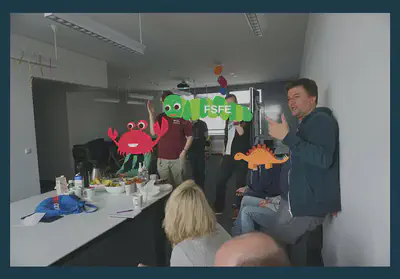How to campaign for the cause of software freedom
Free Software communities produce tons of great software. This software drives innovation and enables everybody to access and use computers, whether or not they can afford new hardware or commercial software. So that’s that, the benefit to society is obvious. Everybody should just get behind it and support it. Right? Well, it is not that easy. Especially when it comes to principles of individual freedom or trade-offs between self-determination and convenience, it is difficult to communicate the message in a way that it reaches and activates a wider audience. How can we explain the difference between Free Software and services available at no cost (except them spying at you) best? Campaigning for software freedom is not easy. However, it is part of the Free Software Foundation Europe’s mission. The FSFE teamed up with Peng! Collective to learn how to run influential campaigns to promote the cause of Free Software. The Peng Collective is a Berlin based group of activists who are known for their successful and quite subversive campaigns for political causes. And Endocode? Endocode is a sponsor of the Free Software Foundation Europe. We are a sponsor because free software is essential to us, both as a company and as members of society. And so here we are.

There are some exciting, courageous and engaging campaigns that focus on communicating complex political goals. The escape helpers campaign leaves the audience conflicted between the two choices of being a good human rights activists (driven by ideals and demonstrating solidarity with refugees) and being a good citizen (by abiding to the law). Great, because the message is to re-think what is legal against what is right. The #slamshell performance emotionally demonstrated the risks associated with oil drilling that are normally regarded as marginal.
These campaigns translate abstract, distant risks or worries into concrete, tangible calls to action. By being provocative, they break the mold and reach a wide audience online and through traditional media. They are “cat content for social change”, as our tutors put it. Campaigners are being urged to stop preaching or complaining and to start using positive communication combined with subversive PR work instead. Such messaging needs punchlines, which requires some kind of hyperbole - dadaism, hijacking attention, or provocation.
Campaign development is still a pretty down to earth task. Through fact finding research and the analysis of campaign goals, supporting allies and potential opponents, answers to the four essential questions are being narrowed down: What is the change that we want to achieve? How can this change be brought about? Who can make that change we want to see? And who has power over the involved people or groups? Setting campaign goals is often a compromise between achieving big changes locally or small changes “globally”. It helps to envision the impact of the campaign through utopia/dystopia brainstorms: What would a world look like where all campaign goals have been achieved perfectly? What would it look like if everything went horribly wrong? These kind of mental exercises also help to explain the relevance of the campaign goals and show how the intended change can affect people’s lives. The goals may be perfectly obvious to those passionate about them already, but not to outsiders - a common problem regarding the ethics and ideals of Free Software.
Implementing a campaign involves many standard, by the book project management tasks. The individual publicity stunts and activities are the actions that form the campaign timeline. A dilemma specific to the FSFE is that the relevant and influential media - social networks especially - are the kind of centralized proprietary platforms against which we are advocating. However, we learned that it may be possible to play this situation to our advantage :-) Since the FSFE’s goals require some heavy lifting of Free Software lobbying, the campaign timeline extends far into the future. We found ourselves thinking about what to present at conferences a year or more into the future. Finalizing the campaign plan involves answering the “classical” question of what time, material and talent is required to perform the tasks, and to put them into a timeline. Often this includes outside help for extra manpower or professional expertise. Noticeably, those with technical backgrounds tend to haste towards a release, underestimating the lead time required to get there, and the duration of the campaign. This tendency works almost, but not quite, entirely unlike in software projects. Securing and confirming the support of allies and protagonists also takes time.
The planned actions need to be reviewed with a focus group that resembles or at least understands the target audience. This review should confirm that the message conveyed is in fact understandable and makes sense. It is not possible to get a clear answer on whether or not a campaign project needs an ultimate decision maker. The answer depends too much on the composition of the campaign team and the timeline of the project. The necessary communication infrastructure is pretty straightforward - tasks boards, and instead and asynchronous messaging. Most Free Software groups use those anyway.
After two and a half days of workshop, all 15 participants ended up rather tired. However we had plenty of fun and learned a lot. Surprisingly, the group came up with a good amount of real, usable ideas for activities. Be very afraid :-) The guidance and mentoring by the experienced campaigners from Peng! Collective helped tremendously. Of course the workshop was merely an exercise in how to develop and run a campaign for software freedom. The bulk of the work is now ahead of us. But we are off to a good start. We are curious where this road will take us.